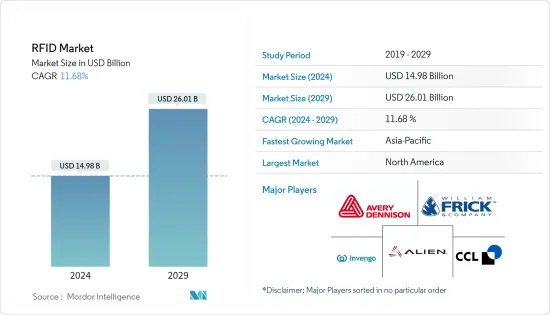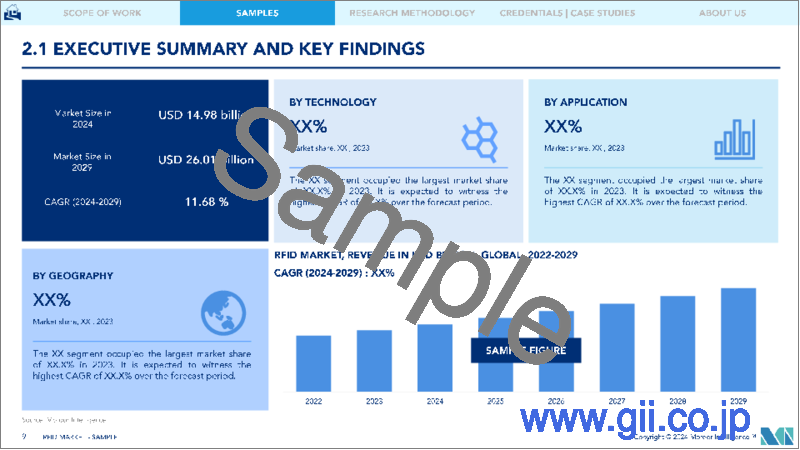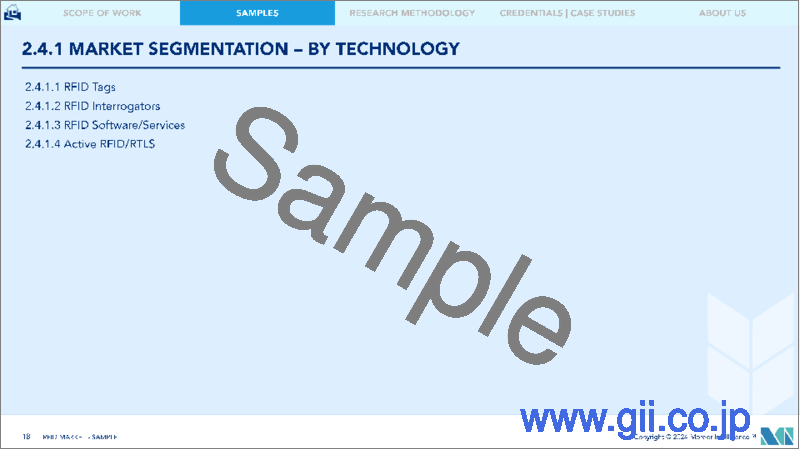|
|
市場調査レポート
商品コード
1436068
RFID:市場シェア分析、業界動向と統計、成長予測(2024~2029年)RFID - Market Share Analysis, Industry Trends & Statistics, Growth Forecasts (2024 - 2029) |
||||||
|
● お客様のご希望に応じて、既存データの加工や未掲載情報(例:国別セグメント)の追加などの対応が可能です。 詳細はお問い合わせください。 |
|||||||
| RFID:市場シェア分析、業界動向と統計、成長予測(2024~2029年) |
|
出版日: 2024年02月15日
発行: Mordor Intelligence
ページ情報: 英文 120 Pages
納期: 2~3営業日
|
- 全表示
- 概要
- 目次
RFID市場規模は2024年に149億8,000万米ドルと推定され、2029年までに260億1,000万米ドルに達すると予測されており、予測期間(2024年から2029年)中に11.68%のCAGRで成長します。

主なハイライト
- サプライチェーン管理と物流では、RFID技術が広く使用されています。製品の原産地を追跡し、サプライチェーン内の汚染源や改ざんを防ぐために、センサーベースのRFID技術が製品パッケージにますます組み込まれています。物流と輸送は、RFID技術の主要な実装分野です。倉庫管理、ヤード管理、出荷と貨物、配送センターなどは、RFID追跡テクノロジーが通常使用される分野の一部です。
- 無線周波数識別(RFID)は主に、タグとリーダーという2つの主要コンポーネントで構成される無線システムを指します。リーダーは基本的に、電波を発し、RFIDタグから返される信号を受信する1つ以上のアンテナを備えたデバイスです。タグは、電波を利用してタグのIDやその他の重要な情報を近くのリーダーに伝達します。タグはパッシブタイプまたはアクティブタイプの場合があります。
- パッシブ RFIDタグは主にリーダーから電力を供給され、バッテリーはありません。ただし、アクティブタイプのRFIDタグは電池によって電力を供給します。これらのRFIDタグは、1つのシリアル番号から数ページの重要なデータに至るまで、幅広い情報を保存できます。 RFIDリーダーはモバイルフォームファクターで提供されるため、手で持ち運んだり、柱や頭上に取り付けたりすることができます。
- RFID技術の最も一般的な用途の1つは、サプライチェーン内の商品の追跡、製造ラインに移動する部品の追跡、資産、セキュリティ、および顧客が現金を使用せずに商品の代金を支払うことができる支払いシステムの追跡です。さらに、RFIDはヘルスケア業界で患者のリストバンドに頻繁に使用され、施設のアクセス制御とセキュリティのために改ざん防止と正確な識別を提供します。
- さらに、世界中の複数の配送センターや倉庫は、改善プログラムの一環として、プロセス全体の効率を高めるためにプロセス効率の改善に投資しています。市場情勢へのこのような投資は、RFID技術の成長と実装を促進すると予想されます。
- 航空業界でも、特にリアルタイムの手荷物追跡などの強化されたサービスを乗客に提供する際に、RFIDラベルの需要が高まっています。 Avery Dennison氏によると、航空業界でRFIDベースのラベルを導入することにより、誤った取り扱い率が13%減少し、航空機の旋回ごとにランプの積載時間が約4分短縮されました。
RFID市場動向
小売セグメントが大きな市場シェアを保持すると予想される
- 小売業におけるRFIDには、RFIDリーダーに信号を発する品目上のRFIDタグの利用が含まれます。信号はソフトウェアによって処理され、取引、棚卸、在庫レベル、または個々の顧客の注文履歴に関するリアルタイムの結果が提供されます。小売におけるRFIDは、手動で時間がかかり、あらかじめ決められた間隔でのみ実行される典型的な小売在庫プロセスを容易にします。商品追跡は、小売業者がRFIDを使用する主要なアプリケーションの1つです。小売業におけるRFIDは、盗難を防止したり、通常は移動されたり置き忘れられたりする商品を追跡するためにも使用できます。
- いくつかの企業が在庫管理のアプローチとしてRFIDを採用しています。リーダーには、Zara、H&M、Target、Macy's、Uniqlo、Nike、Adidas、Lululemon、Footlocker、Levi's、Tommy Hilfiger、Ralph Lauren、Victoria's Secretが含まれます。eコマースが導入の多くを促進しており、店舗フルフィルメントやBOPIS(オンラインで購入し、店舗で受け取る)などのプロセスをサポートするには、高い在庫精度レベルが必要です。より適応性の高い小売業者は、BOPIS(オンラインで購入して店舗で受け取る)などのオムニチャネル製品の合理化や、サプライチェーンの可視性とセルフチェックアウトの改善など、RFIDの新しいアプリケーションを革新しています。
- RFID対応商品により、管理者が事実データを利用できるようになります。在庫の正確性は収縮を抑えて利益を向上させるために重要であるため、より賢明な購入決定につながり、経営陣の経費管理が向上する可能性があります。 RFIDを使用すると、全体的な商品管理が改善される可能性があります。在庫とその場所を正確に追跡することでコストを節約します。また、確実に販売を完了することが容易になるため、売上高の増加にもつながります。要するに、システムを導入すると、商品がどこに保管されているかをより正確に会計処理できるため、より収益性の高いパフォーマンスが保証されます。
- 世界中の小売店は、特にアパレル事業においてRFID技術を広範囲に活用してきました。カナダに本拠を置く企業Logistik Unicorpは、厳格な品質要件を満たすことを保証するとともに、カナダの軍服を迅速に配送するためのツールとして無線周波数識別を使用しています。商品の出荷にかかる時間を35%短縮することができました。このような取り組みは、市場におけるRFIDの新たな機会、開発、取り組みを促進し、小売商品への依存を減らします。
- COVID-19のパンデミックにより、小売業者にとって課題は増大しています。また、パンデミックにより、小売業者はさらに大規模なRFIDの導入を迫られました。パンデミックは、すでに進行していたデジタル変革の動向を加速させるきっかけとなりました。あらゆる販売チャネルで顧客のニーズを満たすオムニチャネル小売戦略が生き残りのための優先事項となった。 RFIDにより、小売業者は店舗、企業、配送センター全体にわたる商品の可視性が拡張され、刻々と変化する消費者の需要に対応できます。
アジア太平洋地域は最も急成長する市場になると予想される
- アジア太平洋地域は市場の重要なシェアを保持すると予想されており、予測期間中に大幅な成長が見込まれると予想されます。オートメーション分野での実装と調査の急速な増加、およびインダストリー4.0の大幅な拡大により、この地域でのRFIDソリューションの需要が高まっています。この地域の成長は、生産性を向上させるために製造ユニットへのこれらのRFIDシステムの設置が増加したことによって大きく推進されました。電子 IDカードやスマートカードに組み込まれたRFIDタグの受け入れが進んでいることも、この地域のRFID市場の成長の原動力となっています。
- 小売部門の拡大は、顧客のショッピング体験を向上させ、倉庫管理プロセスを最適化するためにデジタル技術の導入に注力する小売業者の台頭とともに、RFID市場の成長に貢献する重要な要因の1つとなっています。 RFIDは、生産環境で商品や材料を扱うために使用される効率的なテクノロジーの1つです。この情勢の製造業の拡大は、この分野での自動化および産業用モノのインターネット(IIoT)ソリューションの採用の増加と相まって、市場の成長を推進しています。また、さまざまな業種にわたる組織による資産管理への投資の増加と、スマートシティなどの政府の取り組みと相まって非接触型インフラストラクチャのニーズの高まりが、予測期間中の市場の成長をさらに推進すると予想されます。
- さらに、公共交通部門は、予測期間中に市場が拡大すると予想される分野の1つであると予想されます。ただし、いくつかの制約により市場の成長が制限されています。 RFIDシステムの設置に関連するコストの上昇により、市場の成長が妨げられる可能性があります。デバイスの相互運用性の問題は、予測期間中の市場の成長を妨げる可能性もあります。
- インドなどの国では、産業が成熟するにつれてRFID技術の採用が急増すると予想されており、COVID-19のパンデミックにより非接触ソリューションのニーズが高まっています。テクノロジーの最大の推進力も政府側から来ています。たとえば、2021年8月、南デリー市公社(SDMC)は、首都に入る商用車にRFIDタグの搭載を義務付けると発表しました。 SDMCはまた、商用車のRFIDタグを介してのみ行うことができる通行税または環境補償料の支払いに関する通知を発行しました。また、万引きや盗難による在庫損失を防ぎ、店舗のパフォーマンスを最適化し、交通量カウントとともに在庫インテリジェンスソリューションを実現するために、中国企業は衣料品店、化粧品店、スーパーマーケット、その他の小売店にRFIDソリューションを導入しています。
- さらに、2022年 6月にデリー空港は、RFID技術を利用した個人用手荷物タグを導入しました。これにより、預け入れ荷物がいつ、どのベルトに乗ってターミナルに到着するかについてのリアルタイム情報が乗客に提供されます。
- さらに、2022年 3月、ビスタラ航空はアイルランドに本拠を置く企業ASDと提携し、RFIDAeroCheckテクノロジーを導入して、より迅速なスキャンを実現し、今後の要件に関する正確なデータとタイムリーな情報を確保しました。
RFID業界の概要
RFID市場は競争が激しく、Avery Dennison Corporation、Alien Technology Corporation、CCL Industries Inc.、William Frick & Companyなどの複数の大手企業で構成されています。大手企業は、顧客ベースを海外に拡大することに注力しています。両社は戦略的協力イニシアチブを活用して市場シェアを拡大し、収益性を高めています。競合、急速な技術進歩、消費者の嗜好の頻繁な変化は、予測期間中に企業の市場の成長に脅威をもたらすと予想されます。
- 2022年 10月-Avery Dennison Smartracは、製薬アプリケーション向けのAD Minidose U9 RAIN RFIDインレイを発売し、ヘルスケア、薬局、研究所の資産管理にとって重要なRFID価値を解放しました。 AD Minidose U9は、オーバーン大学のRFID研究室からARC認証(スペック S)を取得し、DoseID業界コンソーシアムによる使用が承認されている市場最小製品の1つです。
- 2022年 5月- デジタル識別技術およびソリューションのプロバイダーであるSMLグループ(SML)は、香港初の無線周波数識別(RFID)インレー研究開発(R&D)センターおよび生産センターであるテクノロジーイノベーション開発センター(TIDC)を立ち上げました。ハブ。新しいセンターは、あらゆるアイテムにデジタルタグが付けられるデジタルファーストの未来に向けて移行する顧客の増加を伴う、ますます世界な事業を推進する技術エコシステムの開発を目指すSMLの戦略的長期計画の一環となります。市場全体のID。
その他の特典
- エクセル形式の市場予測(ME)シート
- 3か月のアナリストサポート
目次
第1章 イントロダクション
- 調査の前提条件と市場の定義
- 調査範囲
第2章 調査手法
第3章 エグゼクティブサマリー
第4章 市場洞察
- 市場概要
- 業界関係者の分析
- RFIDタグの種類
- 業界の魅力- ポーターのファイブフォース分析
- 供給企業の交渉力
- 買い手の交渉力
- 新規参入業者の脅威
- 代替品の脅威
- 競争企業間の敵対関係の激しさ
- RFIDの規制と規格
- RFIDとIoT
- COVID-19がRFIDおよび関連市場に与える影響
- RFID導入の重要な成功要因
- ギャップ分析
第5章 市場力学
- 市場促進要因
- デジタル開発を促進する政府の政策
- 生産性の向上とセキュリティ・アクセス制御アプリケーションのため、製造ユニットへのRFIDの設置が増加
- 市場の課題
第6章 市場セグメンテーション
- 技術別
- RFIDタグ
- RFIDインテロゲーター
- RFIDソフトウェア/サービス
- アクティブRFID/RTLS
- 用途別
- 小売
- ヘルスケア・医療
- 旅客輸送/自動車
- 製造
- 消費者製品
- その他
- 地域別
- 北米
- 欧州
- アジア太平洋地域
- ラテンアメリカ
- 中東とアフリカ
第7章 競合情勢
- 企業プロファイル
- Avery Dennison Corporation
- Alien Technology Corporation
- William Frick &Company
- Invengo Technology Pte Ltd.
- Impinj Inc.
- CCL Industries Inc.
- Nedap NV
- Zebra Technologies Corporation
- Trace-Tech ID Solutions SL
- Hangzhou Century Co. Ltd.
- SML Group Limited
- Honeywell Productivity and Workflow Solutions
- CHILITAG Technology Ltd
- Ceyon Technology Co. Ltd.
- JADAK Technologies Inc.
第8章 投資分析
第9章 市場の将来
The RFID Market size is estimated at USD 14.98 billion in 2024, and is expected to reach USD 26.01 billion by 2029, growing at a CAGR of 11.68% during the forecast period (2024-2029).

Key Highlights
- Supply chain management and logistics make widespread usage of RFID technology. Sensor-based RFID technology is being increasingly integrated into product packaging to track and trace the origin of the product and prevent any source of contamination or tampering within the supply chain. Logistics and transportation are major areas of implementation for RFID technology. Warehouse management, yard management, shipping and freight, and distribution centers are some of the areas where RFID tracking technology is usually used.
- Radiofrequency identification (RFID) primarily refers to a wireless system comprising two major components: tags and readers. The reader is basically a device comprising one or more antennas that emits radio waves and receive signals back from the RFID tags. The tags, which make use of radio waves to communicate their identity and other crucial information to the nearby readers, can be passive or active type.
- The passive RFID tags are mainly powered by the readers and do not have a battery. However, the active type RFID tags are powered by batteries. These RFID tags can store a wide range of information, right from one serial number to several pages of crucial data. The RFID readers are offered in a mobile form factor so that they can be carried by hand or can either be mounted on a post or overhead.
- One of the most common usages of RFID technology has been tracking goods in the supply chain, tracking parts moving to a manufacturing production line, tracing assets, security, and payment systems that let clientele pay for items without using cash. In addition, RFID is frequently used in the healthcare industry on patient wristbands to offer tamper-proof, exact identification for facility access control and security.
- Moreover, multiple distribution centers and warehouses around the globe have been investing in improving their process efficiency to increase the efficiency of the overall processes as a part of their improvement programs. Such investments in the market landscape are anticipated to drive the growth and implementation of RFID technology.
- There has also been an increasing demand in the aviation sector for RFID labels, especially in providing enhanced services for passengers, such as real-time baggage tracking. According to Avery Dennison, implementing RFID-based labels in the Aviation industry has reduced mishandling rates by 13% and has cut ramp loading time by around 4 minutes per aircraft turn.
RFID Market Trends
Retail Segment is Expected to Hold a Major Market Share
- RFID in retail involves the utilization of RFID tags on items that emit signals to RFID readers, which are then processed by the software, providing real-time results for transactions, stock taking, inventory levels, or individual customer purchase order history. RFID in retail eases the typical retail inventory process, which is manual, time-consuming, and only performed at predetermined intervals. Item tracking is one of the major applications that retailers use RFID. RFID in retail can also be used to prevent theft and track items that are usually moved and often misplaced.
- Several companies have adopted RFID as an approach to control inventories. Leaders include Zara, H&M, Target, Macy's, Uniqlo, Nike, Adidas, Lululemon, Footlocker, Levi's, Tommy Hilfiger, Ralph Lauren, and Victoria's Secret. E-commerce is fueling much of the adoption, with high inventory accuracy levels required to support processes like store fulfillment and BOPIS (buy online, pick up in-store). More adaptive retailers are innovating new applications of RFID, such as streamlining omnichannel offerings, such as BOPIS (buy online and pick up in-store), as well as improving supply chain visibility and self-checkout.
- RFID-processed merchandise also makes factual data available to management. It may lead to smarter purchase decisions and give management better expense control, as inventory accuracy is crucial to lowering shrinkage, thus, better profits. Usage of RFID may improve overall merchandise management; accurate tracking of inventory and its location saves money. It also drives greater topline revenues, as it becomes easier to assure that sales are completed. Bottom line, adoption of the system ensures more profitable performance, as there is a more accurate accounting of the merchandise wherever it is stored.
- Retailers across the world have been making extensive use of RFID technology, especially in the Apparel business. The Canada-based company, Logistik Unicorp, has been using radio frequency identification as a tool to ensure that Canadian military uniforms are delivered swiftly, along with the guarantee of meeting strict quality requirements. It has been able to reduce the time required to ship goods by 35%. Such initiatives encourage new opportunities and developments and initiatives for RFID in the market and decrease the dependency on retail goods.
- The COVID-19 pandemic has increased challenges for retailers. The pandemic also pushed retailers to adopt RFID on a much larger scale. The pandemic became an accelerator of the digital transformation trend, which was already underway. Omnichannel retail strategies to meet the customers' needs on all sales channels became a priority for survival. RFID extended retailers' visibility of merchandise across the stores and the enterprise and distribution centers to meet ever-changing consumer demands.
Asia Pacific is Expected to be the Fastest Growing Market
- The Asia Pacific region is anticipated to hold a significant share of the market and is expected to witness significant growth over the forecast period. The rapidly increasing implementation and research work in the field of automation and a significant expansion of industry 4.0 have been driving the demand for RFID solutions in the region. The region's growth has been significantly driven by the increasing installation of these RFID systems in manufacturing units in order to improve productivity. The growing acceptance of electronic identity cards and RFID tags that are located in smart cards is also acting as a driver for the growth of the RFID market in the region.
- The expanding retail sector, along with the rising retailers' focus on embracing digital technologies in order to enhance the customer's shopping experience and optimize the warehouse management process, has also been one of the key factors contributing to the growth of the RFID market. RFID has been one of the efficient technologies used to handle goods and materials in the production environment. The expanding manufacturing landscape in the region, coupled with the increasing adoption of automation and Industrial Internet of Things (IIoT) solutions in the sector, has been propelling the market's growth. Also, the growing investments in asset management by organizations across various verticals and the rising need for contactless infrastructure coupled with government initiatives such as smart cities will further drive the growth of the market during the forecast period.
- Moreover, the public transportation sector is anticipated to be one of the areas in which the market is expected to expand over the forecast period. However, some restraints are limiting the growth of the market. The higher cost associated with installing RFID systems may challenge the market's growth. The device interoperability issues can also hinder the growth of the market over the forecasted period.
- Countries such as India are expected to witness a surge in the adoption of RFID technology as industries mature, and the COVID-19 pandemic is increasing the need for contactless solutions. The biggest boost for technology is also coming from the government side. For instance, in August 2021, the South Delhi Municipal Corporation (SDMC) announced that it mandated commercial vehicles to carry RFID tags to enter the national capital. SDMC has also issued a notice regarding the payment of toll tax or environment compensation charges, which can only be made through an RFID tag for commercial vehicles. Also, to protect inventory loss from shoplifting and theft, optimize store performance, and enable inventory intelligence solutions along with traffic counting, Chinese companies have been deploying RFID solutions in their clothing stores, cosmetics stores, supermarkets, and other retail stores.
- Moreover, in June 2022, Delhi Airport introduced a personalized baggage tag, enabled by radio frequency identification (RFID) technology, which will give passengers real-time information about when and on which belt is their check-in luggage arriving at the terminal.
- Furthermore, in March 2022, Vistara Airlines partnered with an Ireland-based company, ASD, to deploy RFIDAeroCheck technology for quicker scans ensuring accurate data and timely information regarding upcoming requirements.
RFID Industry Overview
The RFID Market is highly competitive and consists of several major players like Avery Dennison Corporation, Alien Technology Corporation, CCL Industries Inc., William Frick & Company, etc. The major players are focusing on expanding their customer base across foreign countries. The companies are leveraging strategic collaborative initiatives to increase their market share and increase their profitability. The competition, rapid technological advancements, and frequent changes in consumer preferences are expected to pose a threat to the market's growth of the companies during the forecast period.
- October 2022 - Avery Dennison Smartrac launched its AD Minidose U9 RAIN RFID inlay for pharmaceutical applications, unlocking critical RFID value for healthcare, pharmacies, and laboratory asset management. AD Minidose U9 is one of the smallest products on the market to receive ARC certification (Spec S) from Auburn University's RFID Lab and to be approved for use by the DoseID industry consortium.
- May 2022 - SML Group (SML), a digital identification technology and solutions provider, launched its Technology Innovation Development Center (TIDC), a first-in-Hong Kong Radio Frequency Identification (RFID) inlay Research & Development (R&D) center and production hub. The new center would be a part of SML's strategic long-term plans as it seeks to develop the technology ecosystem to power increasingly global operations that involve a growing pool of customers transitioning towards a digital-first future where every item will be tagged with a digital ID across markets.
Additional Benefits:
- The market estimate (ME) sheet in Excel format
- 3 months of analyst support
TABLE OF CONTENTS
1 INTRODUCTION
- 1.1 Study Assumptions and Market Definition
- 1.2 Scope of the Study
2 RESEARCH METHODOLOGY
3 EXECUTIVE SUMMARY
4 MARKET INSIGHT
- 4.1 Market Overview
- 4.2 Industry Stakeholder Analysis
- 4.3 RFID Tag Types
- 4.4 Industry Attractiveness - Porter's Five Forces Analysis
- 4.4.1 Bargaining Power of Suppliers
- 4.4.2 Bargaining Power of Buyers
- 4.4.3 Threat of New Entrants
- 4.4.4 Threat of Substitutes
- 4.4.5 Intensity of Competitive Rivalry
- 4.5 RFID Regulations and Standards
- 4.6 RFID and IoT
- 4.7 Impact of COVID-19 on RFID and Allied Markets
- 4.8 Critical Success Factors for RFID Implementation
- 4.9 Gap Analysis
5 MARKET DYNAMICS
- 5.1 Market Drivers
- 5.1.1 Government Policies Favoring Digital Development
- 5.1.2 Increasing Installation of RFID in Manufacturing Units for Productivity Improvement and Security and Access Control Applications
- 5.2 Market Challenges
6 MARKET SEGMENTATION
- 6.1 By Technology
- 6.1.1 RFID Tags
- 6.1.2 RFID Interrogators
- 6.1.3 RFID Software/Services
- 6.1.4 Active RFID/RTLS
- 6.2 By Application
- 6.2.1 Retail
- 6.2.2 Healthcare and Medical
- 6.2.3 Passenger Transport/Automotive
- 6.2.4 Manufacturing
- 6.2.5 Consumer Products
- 6.2.6 Other Applications
- 6.3 By Geography
- 6.3.1 North America
- 6.3.2 Europe
- 6.3.3 Asia Pacific
- 6.3.4 Latin America
- 6.3.5 Middle East and Africa
7 COMPETITIVE LANDSCAPE
- 7.1 Company Profiles
- 7.1.1 Avery Dennison Corporation
- 7.1.2 Alien Technology Corporation
- 7.1.3 William Frick & Company
- 7.1.4 Invengo Technology Pte Ltd.
- 7.1.5 Impinj Inc.
- 7.1.6 CCL Industries Inc.
- 7.1.7 Nedap NV
- 7.1.8 Zebra Technologies Corporation
- 7.1.9 Trace-Tech ID Solutions SL
- 7.1.10 Hangzhou Century Co. Ltd.
- 7.1.11 SML Group Limited
- 7.1.12 Honeywell Productivity and Workflow Solutions
- 7.1.13 CHILITAG Technology Ltd
- 7.1.14 Ceyon Technology Co. Ltd.
- 7.1.15 JADAK Technologies Inc.




